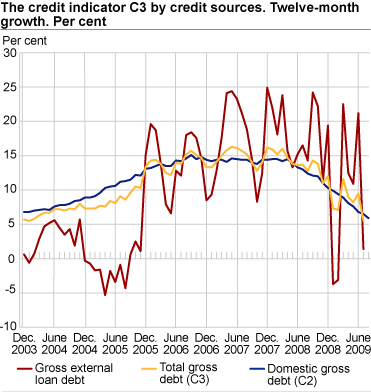Content
Published:
This is an archived release.
Increase in mainland Norway's foreign debt
The twelve-month growth in mainland Norway's foreign debt was 18.4 per cent to end-July, up from 16.7 per cent to the previous month. The increase emanates from short-term debt.
Mainland Norway accounted for almost 60 per cent of the public gross external loan debt. The foreign debt of mainland Norway amounted to NOK 460 billion at end-July.
Offshore industries accounted for the remaining part of the foreign debt. For this part of the foreign debt, the annual growth decreased from 26 per cent to -17.1 per cent in July. The decrease emanates from short-term debt, where the major part is corporations’ internal loan debt. As shown in the boxes below, the figures can fluctuate considerably from month to month.
The general public gross foreign debt, which mainly relates to non-financial enterprises, went down from NOK 941 billion to NOK 790 billion in July. The twelve-month growth in public gross external loan debt decreased from 21.2 per cent to 1.4 per cent during July.
Decrease in total gross debt growth
The twelve-month growth in total gross debt (C3) was 5.5 per cent to end-July, down from 9.5 per cent to end-June. Total gross debt amounted to NOK 4 174 billion at end-July; a decrease from NOK 4 325 billion at end-June. About 89 per cent of the gross debt came from mainland Norway.
Decline in domestic gross debt growth
The credit indicator C2 amounted to NOK 3 384 billion at end-July. The twelve-month growth was 6.5 per cent, down from 6.8 per cent in the previous month. The debt growth in non-financial enterprises was 4.7 per cent, while the growth in household debt was 6.5 per cent. The C2 statistics show that the annual growth in the general public domestic gross debt continued to fall to 5.9 per cent to end-August this year.
| Feb. 2009 | Mar. 2009 | Apr. 2009 | May 2009 | Jun. 2009 | Jul. 2009 | ||||||||||||||||||||||||||||||||||
|---|---|---|---|---|---|---|---|---|---|---|---|---|---|---|---|---|---|---|---|---|---|---|---|---|---|---|---|---|---|---|---|---|---|---|---|---|---|---|---|
| Total gross debt (C3) | 7.1 | 11.6 | 9.0 | 8.2 | 9.5 | 5.5 | |||||||||||||||||||||||||||||||||
| Total gross loan debt, mainland-Norway | 8.3 | 9.5 | 9.3 | 8.5 | 7.0 | 6.8 | |||||||||||||||||||||||||||||||||
| Domestic gross debt (C2)1 | 9.4 | 8.9 | 8.1 | 7.6 | 6.8 | 6.5 | |||||||||||||||||||||||||||||||||
| Gross external loan debt | -3.1 | 22.5 | 12.5 | 10.9 | 21.2 | 1.4 | |||||||||||||||||||||||||||||||||
| Gross external loan debt, offshore ind. | -17.6 | 23.7 | -1.4 | -3.1 | 26.0 | -17.1 | |||||||||||||||||||||||||||||||||
| Gross ext. loan debt, mainland-Norway | 7.4 | 21.5 | 24.1 | 22.4 | 16.7 | 18.4 | |||||||||||||||||||||||||||||||||
| 1 | The growth rates for C2 are in the table presented as they were at the time of the C3 release. |
|
The statistics for external loan debt are based on samples, and therefore associated with more uncertainty than the statistics for domestic debt (C2). For more details concerning sampling, see chapter 3.3 in About the statistics . |
|
C3 is an approximate measure of the size of the total gross debt of the public (households, non-financial enterprises and municipalities) in NOK and foreign exchange. C3 comprises the sum of C2 (the public’s domestic gross debt) and the public’s external loan debt of which C2 constitutes the largest part. The C3 statistics are published approximately one month later than C2. It should be noted that the growth rates for the public’s gross external loan debt vary from month to month due to shifting amounts of short-time internal debt by oil companies. In addition, the first-time-published growth rates are often revised at a later date due to improved information. For more details concerning the public’s gross external loan debt see StatBank. |
The statistics is now published as Credit indicator.
Contact
-
Statistics Norway's Information Centre
E-mail: informasjon@ssb.no
tel.: (+47) 21 09 46 42

